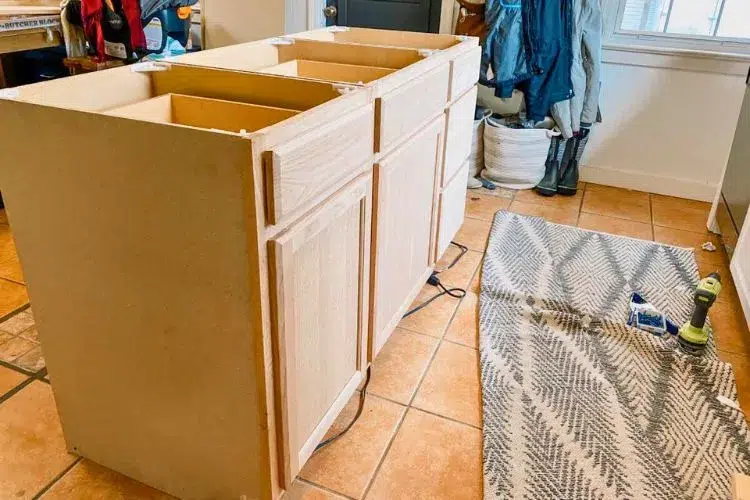Welcome to this informative article exploring the ins and outs of attaching a kitchen island to the floor.
As a central feature in many modern homes, kitchen islands have become popular for homeowners looking to maximize functionality and add a stylish touch to their kitchens.
But, do you know how is a kitchen island attached to the floor?
Well, in this article will delve into the various methods used to attach a kitchen island to the floor. We will guide you through the process step-by-step and provide helpful tips to ensure your island remains a stable and secure addition to your home.

How is a kitchen island attached to the floor?
A kitchen island is attached to the floor using a combination of brackets, bolts, and/or cleats, depending on the island’s design and the type of flooring.
First, the island is positioned in the desired location, and the floor is marked to indicate where the brackets or cleats will be installed.
Then, holes are drilled into the floor, and anchor bolts or screws are inserted to secure the brackets or cleats. Finally, the island is positioned over the secured brackets or cleats and fastened using appropriate hardware.
The process may vary slightly based on the specific island and flooring materials. Still, the overall goal is to ensure a stable and secure connection between the island and the floor.
How to remove the kitchen island from floor?
Removing a kitchen island from the floor can be straightforward if you follow these steps carefully. Before starting:
- Gather the necessary tools, such as a drill or wrench.
- Pry bar.
- Ensure you have enough space to work.

Disconnect Utilities
- Turn off the Power and Water Supply: Before beginning the removal process, ensure that all utilities connected to the island, such as electricity and water, are turned off. Locate the circuit breaker and water shut-off valve and turn them off to prevent accidents.
- Disconnect Appliances and Plumbing: Remove any appliances, such as ovens or dishwashers, from the island. Disconnect plumbing fixtures, like sinks, by loosening and carefully detaching the connections.
Remove Countertop
- Detach the Countertop: Examine the countertop’s attachment points, including screws, brackets, or adhesive. Carefully remove any fasteners or cut through the adhesive with a utility knife.
- Lift the Countertop: With the help of another person, lift the countertop of the island base. Be cautious not to damage the countertop or the floor while removing it.
Detach the Island Base

- Locate Attachment Points: Inspect the island base to find the attachment points where it is secured to the floor. These may include brackets, bolts, or cleats.
- Remove Hardware: Remove the screws or bolts that secure the island to the floor using a drill or wrench. If the island is attached using adhesive, use a pry bar to carefully separate the island base from the floor.
Remove the Island Base
Lift and Move the Island Base: With the help of another person, lift the island base off the floor, being cautious not to damage the flooring. Move the island base to the desired location or out of the room.
Clean and Repair the Area
- Remove Remaining Adhesive or Hardware: After removing the island, clean any remaining adhesive or hardware from the floor. Use a scraper or adhesive remover to eliminate residue.
- Repair Flooring: If necessary, repair or replace any damaged flooring where the island was removed. This may include filling holes or installing new flooring materials.
How much does it cost to remove a kitchen island?
The cost to remove a kitchen island can vary based on several factors, including the size and complexity of the island, the materials used, and whether any utilities need to be disconnected.
On average, you can expect to pay between $300 and $800 for a professional to remove a kitchen island.

This cost typically includes labor, disposal of the old island, and minor repairs to the flooring.
However, if the island has additional features such as plumbing, electrical connections, or built-in appliances, the cost may increase due to the added complexity of the removal process.
Remember that these figures are estimates, and the actual cost will depend on your specific situation and the rates charged by local professionals.
Conclusion:
In conclusion, the cost of removing a kitchen island can vary depending on several factors, including the size, materials, and complexity of the island and any additional features like plumbing and electrical connections.
While the average cost ranges from $300 to $800, it’s essential to consider the specific circumstances of your project and obtain quotes from local professionals to get an accurate estimate.
By carefully evaluating these factors and seeking professional assistance, you can ensure a smooth and successful removal process, paving the way for a refreshed, updated kitchen space that meets your needs and preferences.


